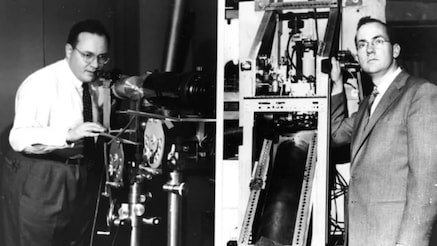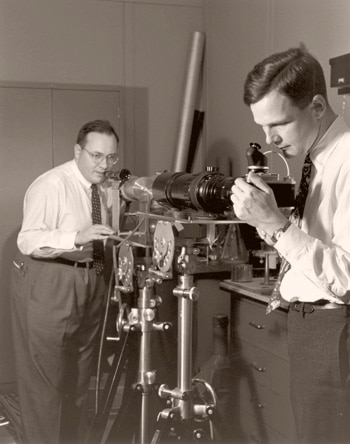Arthur L Schawlow, a Bell Labs researcher, and Charles H Townes, a consultant to Bell Labs, weren’t planning to invent a device that would revolutionize a number of industries, from communications to medicine. They had something more straightforward in mind: developing a device to help them study molecular structures.
In the 1940s and early 1950s they had developed an interest in the field of microwave spectroscopy, which had emerged as a powerful tool for revealing the characteristics of a wide variety of molecules. Yet through that investigation into microwave spectroscopy, Schawlow and Townes conceived of the laser, publishing their findings in 1958 as “Infrared and Optical Masers.” That paper, published in Physical Review, the journal of the American Physical Society, launched a new scientific field and opened the door to a multibillion-dollar industry.
Imperatives of World War II at Bell Labs
Townes, armed with a PhD degree in physics from the California Institute of Technology, joined Bell Labs in 1939, where he worked on a variety of problems, including microwave generation, vacuum tubes and magnetics. He then moved on to solid-state physics, studying electron emissions from surfaces.
One day, about a year after Townes arrived at Bell Labs, Mervin Kelley, then director of Townes’ laboratory, informed the group, “On Monday, I want you to start a radar bombing system.” [1] Townes wasn’t enthusiastic about the assignment, but realized that World War II had invaded the quiet hallways of Bell Labs. “We worked at it pretty hard, and after about a year we had a system which we put in an airplane, and actually used. It worked.”
During these war years, Townes was becoming more interested in radio astronomy, but his defense work on radar led him to focus on microwave spectroscopy. Radar systems broadcast radio signals at specific wavelengths. When these signals strike solid objects, such as a battleship or an airplane, the signals that reflect back to the radar system can be correlated to identify the object and its position.
The radar navigation bombing systems Townes was working on used wavelengths of 10 centimeters (cm) and then 3 cm, but the military wanted to go to 1¼ cm to get better directivity and to use smaller antennae on their planes.
Townes was concerned about going to wavelengths of 1¼ cm. He knew, from the research of others, that gas molecules can absorb wave forms at certain wavelengths, and he feared that the water vapor in the atmosphere — fog, rain and clouds — might absorb the 1¼ cm radar signals. ”Well, the radar was built, it was tried out, and it didn’t work; there was water vapor absorption,” he said. The system could ”see” for just a few miles at best, which was “much, much too limited then for searching over the ocean for ships or anything like that.”
Molecular spectroscopy at Columbia University
After the war, Townes focused his work at Bell Labs on molecular spectroscopy and in 1948 had the opportunity to move to Columbia University. “Now, I left to go to Columbia partly because Columbia was more interested in the physics and the principles which I was interested in. And furthermore, I liked university life much better anyhow — I really always wanted to be in a university.”
The discipline of microwave spectroscopy was the common ground on which Schawlow and Townes first met in 1949, when Schawlow, having just received his PhD in physics at the University of Toronto, went to Columbia University on a fellowship and began working with Townes.
While at Columbia, Townes continued to mull over the possibility of using stimulated emissions to probe gasses for molecular spectroscopy. Townes knew that as the wavelength of microwave radiation grew shorter, its interactions with molecules became stronger, making it a more powerful spectroscopic tool. Building a device small enough to generate the required wavelength, however, was beyond fabrication techniques of the day. Townes got around that limitation with the idea of using molecules to generate the desired frequencies.
There were several technical questions that had to be worked out, including getting around the Second Law of Thermodynamics, which, in effect, told Townes molecules couldn't generate more than a certain amount of energy.
The idea how to get around this law came to him while he was attending a scientific committee meeting on milliwave emissions in Washington, D.C. Townes took an early morning walk one day in Franklin Park, and considered his problem. As Townes recalled, “I thought, now wait a minute! The Second Law of Thermodynamics assumes thermal equilibrium. We don’t have to have that!”
He pulled an envelope out of his jacket and started to jot down a calculation on how many molecules he needed in a resonator to get the power output he wanted. Then he went back to his hotel and told his idea to Schawlow, who also was in Washington for a conference. “I talked to him about it and Art immediately saw the point and said, 'That’s interesting.’”
When Townes returned to Columbia, he asked his graduate student James P Gordon if he wanted to work on the project, telling him, “I think it is going to work, but I can’t be sure.” He later hired HL Zeiger to assist. Schawlow didn’t work on the maser, but noted that he “had witnessed the disclosure in his [Townes’] notebook.”
That same year, Schawlow left Townes and Columbia to accept a job as a researcher at Bell Labs. “My research at Bell Labs was on superconductivity,” he said, “and I did not participate at all in the exciting developments on masers during the next few years.”
Working on the maser “peacefully”
Townes decided to work with ammonia, which is a very strong absorber and interacts strongly with wavelengths. “It was an old favorite of mine and I knew a lot about it, we had cavities at that wavelength (1¼ cm) and we had all the techniques and we had the wave guides.”
While he worked on the maser, not too many others showed much interest in his idea, so “we could work along peacefully on it in a graduate student kind of style for three years, and we finally made it work and nobody else was trying to do it that I knew of.”
In 1953, he, Gordon and Zeiger demonstrated a working device, that Townes called the maser, which stands for microwave amplification by stimulated emission of radiation. They patented the device through Columbia University.
Extending the maser principle at Bell Labs
Townes realized that the shorter wavelengths beyond those of microwaves — the wavelengths of infrared and optical light — probably offered even more powerful tools for spectroscopy than that produced by the maser.
In 1956, while still at Columbia, Townes was offered a consulting job with Bell Labs, where he would visit the labs, talk to people, look at projects and exchange ideas. “Well, that was a nice kind of consulting job, so I accepted it.”
Townes, still thinking about stimulating the emission of light, stopped in to see Schawlow, now his brother-in-law, who had been at Bell Labs for about five years. The two scientists had collaborated in the past and in 1955 co-authored the book Microwave Spectroscopy. Schawlow later described the collaboration: “I was beginning to think seriously about the possibility of extending the maser principle from the microwave region to shorter wavelengths, such as the infrared region of the spectrum. It turned out that he was also thinking about this problem, so we decided to look at the problem together.”
Schawlow’s idea was to arrange a set of mirrors, one at each end of a device’s cavity, to bounce the light back and forth, which would eliminate amplifying any beams bouncing in other directions. Schawlow and Townes discussed this possibility and both were enthusiastic about it. In the fall of 1957, they began working out the principles of a device that could provide these shorter wavelengths.
Schawlow thought that, with mirrors, their dimensions could be adjusted so that this new device — dubbed a laser — would have only one frequency, that a particular frequency would be chosen within a line width and that the mirror size could be adjusted so that even slight off-angle motion could be dampened. In effect, he was eliminating most of the cavity and keeping only the two ends.
“Without interrupting our other duties, over the next few months we worked on this in odd moments,” Schawlow said. While Schawlow was working on the device, Townes worked on the theory. Schawlow also suggested using certain solid-state materials for solid-state lasers.
U.S. Patent #2,929,922
After eight months of work, the collaboration was fruitful. In 1958, the two men wrote a paper on their work, although they had not yet made an actual laser, and they applied for a patent through Bell Labs. Their proposal that the principles of the maser could be extended to the optical regions of the spectrum was published in the December issue of Physical Review.
In 1961, Schawlow left Bell Labs to take a teaching and research job at Stanford, where he developed the laser’s use in spectroscopy. “Stanford made an offer I couldn’t refuse,” he explained.
Winning the Nobel Prize
In 1964, Townes shared the Nobel Prize in Physics with A Prokhorov and N Basov of the Lebedev Institute in Moscow for “fundamental work in the field of quantum electronics which has led to the construction of oscillators and amplifiers based on the maser-laser principle.”
In 1981, Schawlow shared the Nobel Prize in Physics for his “contribution to the development of laser spectroscopy. It’s long overdue,” Townes said of his colleague’s honor at the time.
Schawlow recalled then of the invention, “We thought it might have some communications and scientific uses, but we had no application in mind. If we had, it might have hampered us and not worked out as well.”
Epilogue: The physics of lasers
The word laser is an acronym for Light Amplification by Stimulated Emission of Radiation, although common usage today is to use the word as a noun — laser — rather than as an acronym — LASER. A laser is a device that creates and amplifies a narrow, intense beam of coherent light.
Atoms emit radiation. We see it every day when the excited neon atoms in a neon sign emit light. Normally, they radiate their light in random directions at random times. The result is incoherent light, a technical term for what you would consider a jumble of photons going in all directions.
The trick in generating coherent light — of a single or just a few frequencies going in one precise direction — is to find the right atoms with the right internal storage mechanisms and create an environment in which they can all cooperate to give up their light at the right time and all in the same direction.
In a laser, the atoms or molecules of a crystal, such as ruby or garnet — or of a gas, liquid or other substance — are excited in what is called the laser cavity so that more of them are at higher energy levels than are at lower energy levels. Reflective surfaces at both ends of the cavity permit energy to reflect back and forth, building up in each passage.
If a photon whose frequency corresponds to the energy difference between the excited and ground states strikes an excited atom, the atom is stimulated as it falls back to a lower energy state to emit a second photon of the same (or a proportional) frequency, in phase with and in the same direction as the bombarding photon.
This process is called stimulated emission. The bombarding photon and the emitted photon may then each strike other excited atoms, stimulating further emission of photons, all of the same frequency and phase. This process produces a sudden burst of coherent radiation as all the atoms discharge in a rapid chain reaction.
Laser sizes and uses
First built in 1960, lasers now range in size from semiconductor lasers as small as a grain of salt to solid-state and gas lasers as large as a storage building. The light beam produced by most lasers is pencil-thin and maintains its size and direction over very large distances.
Lasers are widely used in industry for cutting and boring metals and other materials, in medicine for surgery, and in communications, scientific research and holography. They are an integral part of such familiar devices as barcode scanners used in supermarkets, scanners, laser printers, and compact disk players.
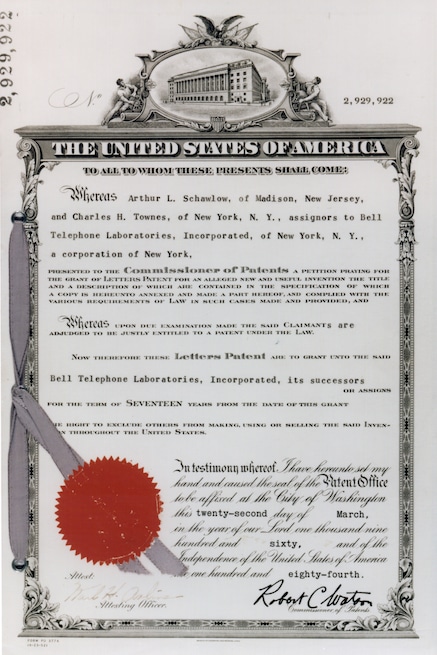
Schawlow and Townes received a patent for the invention of the laser, the same year a working laser was built by Theodore Maiman at Hughes Aircraft Company.
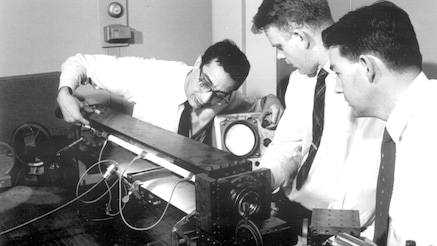
Ali Javan (left) works with an early laser while other researchers look on.
Learn more
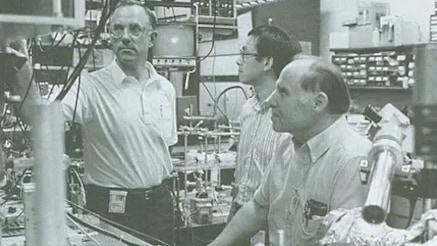
Awards
1997 Nobel Prize in Physics
Development of methods to cool and trap atoms with laser light.

Research project
Optical communication
Bell Labs is advancing optical technology beyond Shannon's limit, using multi-fiber, multi-mode, and multi-core systems to meet future capacity needs and enable automation.
References
[1] All quotations are from A Life in Physics: Bell Telephone Laboratories and the Laser, MIT and Government Service, California and Research in Astrophysics, by Charles H Townes, an oral history conducted in 1991–1992 by Suzanne B Riess, Regional Oral History Office, the Bancroft Library, Berkeley, 1994, with a foreword by Arthur L Schawlow. Reproduction by permission of the author.
